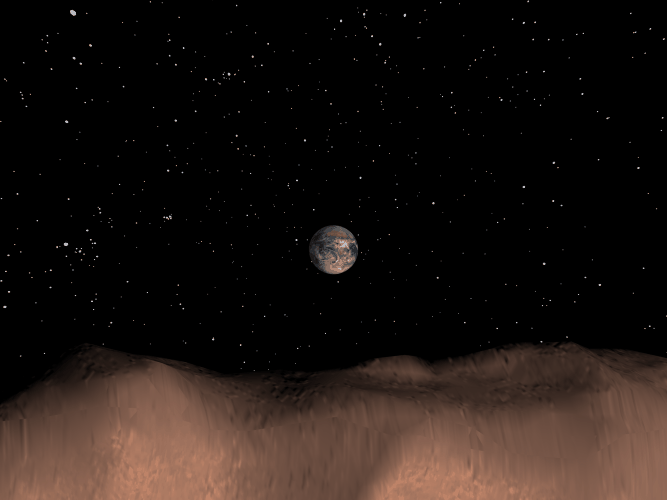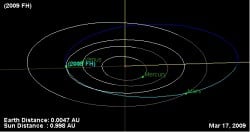[/caption]Another asteroid is set to make a close approach of 79,000 km according to NASA, a distance twice that of geosynchronous orbit around the Earth. Although the 15-20 metre-wide rock is not expected to cause any problems to Earth or satellites, some observers may be lucky to spot the faint light from 2009 FH as it passes.
Interestingly, this new object comes only two weeks after a larger (50 metre wide) asteroid was spotted passing the Earth at a similar distance. So it begs the question, why are we seeing so many asteroids lately?
"
This asteroid flyby will be a good viewing opportunity for both professional and amateur astronomers
," said Don Yeomans from the Near-Earth Object Office at NASA's Jet Propulsion Laboratory in Pasadena, California. "
The asteroid poses no risk of impact to Earth now or for the foreseeable future
."
NASA is always very quick to point out these objects are harmless, passing the Earth at a very safe distance, often beyond the Moon's orbit. However, 2009 FH will pass at a similar distance to the 50 metre-wide
2009 DD45 on March 2nd
.
[caption id="attachment_27363" align="alignleft" width="250" caption="The orbit of 2009 FH (NASA JPL Small-Body Database Browser)"]
[/caption]In this case, 2009 FH will pass through the constellation of Gemini, as bright as a 14th magnitude star. Unfortunately there appears to be some fuzziness as to the time of observing opportunity.
SpaceWeather.com
reports that the best time to observe the asteroid has already passed (after sunset on March 17th, over North America), however, the
NASA JPL news release
states that close approach occurs at 5:17 am PST Wednesday morning. There is little more information available. However,
check the 2009 FH ephemerides for more information
.
This discovery was made by NASA's Near Earth Object Observation Program, known as
Spaceguard
, to detect and track potentially hazardous asteroids that stray close to the Earth. It appears the
Spaceguard
team are getting better and better at spotting these chunks of rock. Although it might seem there are a lot more asteroids than before, this isn't the case, we're just getting better at finding them.
Sources:
NASA
,
Spaceweather.com
 Universe Today
Universe Today

